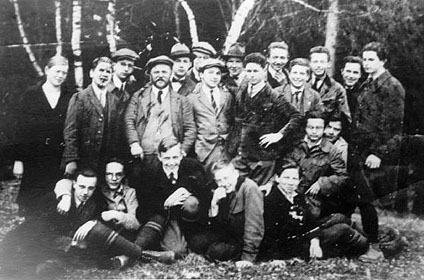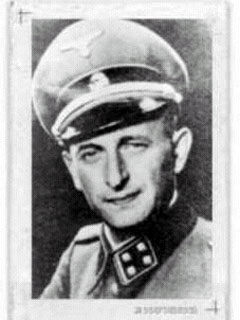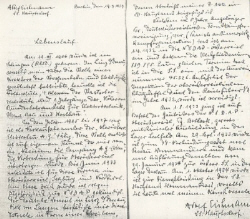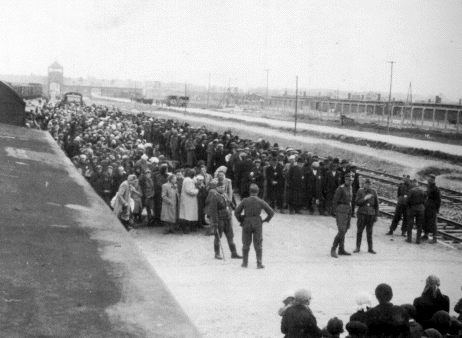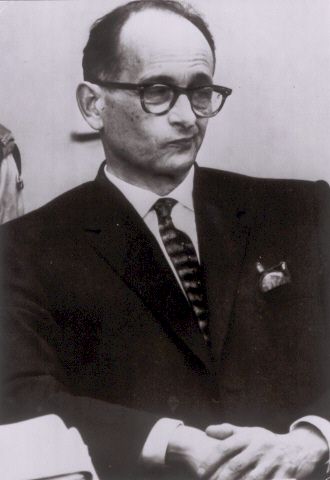Holocaust Education & Archive Research Team |
|
Holocaust Prelude Early Nazi Leaders Nazi Propaganda Nazi Racial Laws Sinti & Roma Kristallnacht The SS SS Leadership Wannsee
Prelude Articles Image Galleries | ||||
Adolf Eichmann "The bureaucrat killer"
Born in Solingen, Germany, Adolf Eichmann was the son of a businessman and industrialist, Karl Adolf Eichmann. In 1914, his family moved to Linz, Austria, and during the First World War, Eichmann's father served in the Austro-Hungarian Army. At the war's conclusion, Eichmann's father returned to the family business in Linz. In 1920, Eichmann's family moved back to Germany. His education incomplete, he left school in 1921. He worked at a variety of jobs, the most successful being as a sales representative for the Vacuum Oil Company. On the advice of old family friend Ernst Kaltenbrunner, Eichmann joined the Austrian branch of the NSDAP (member number 889 895) and of the SS, enlisting on 1 April 1932, as an SS-Anwärter. He was accepted as a full SS member that November, appointed an SS-Mann, and assigned the SS number 45326. For the next year, Eichmann was a member of the Allgemeine-SS and served in a mustering formation operating from Salzburg. In September 1934 Eichmann landed a position in Heydrich's SD, the powerful SS security service. There he started out as a filing clerk cataloguing information about Freemasons. Predictably, the Nazis believed that the Masons were assisting the Jews in their attempts to gain world domination. Eichmann's job was to compile information on prominent Freemasons in Germany. However he was soon assigned to the Jewish section, which was busy collecting information on all prominent Jews. This marked the beginning of Eichmann's interest in the Jews. He studied all aspects of Jewish culture, attended Jewish meetings and often visited Jewish sections of cities while taking volumes of notes. He became familiar with the issue of Zionism, studied Hebrew and could even speak a bit of Yiddish. He gradually became the acknowledged 'Jewish specialist,' realizing this could have positive implications for his career in the SS. He soon attracted the attention of Heydrich and Reichsführer-SS Heinrich Himmler, who appointed Eichmann to head a newly created SD Scientific Museum of Jewish Affairs. He was eventually recognized as an expert on Jewish affairs and with the Nazi takeover of Austria in March of 1938, Eichmann was sent to Vienna where he established a Central Office for Jewish Emigration. This office had the sole authority to issue permits to Jews desperately wanting to leave Austria and became engaged in extorting wealth in return for safe passage. Nearly a hundred thousand Austrian Jews managed to leave with most turning over all their worldly possessions to Eichmann's office, a concept so successful that similar offices were established in Prague and Berlin. In 1939 Eichmann returned to Berlin where he was appointed the head of Gestapo Section IV D4 of the new Reich Main Security Office (RSHA). He was now responsible for implementation of Nazi policy toward the Jews in Germany and all occupied territories (eventually totalling 16 countries). Eichmann thus became one of the most powerful men in the Third Reich and would remain head of IV D/B4 for the remainder of the Reich’s existence. With the outbreak of war, Eichmann oversaw a fundamental change in policy – from "voluntary" emigration to forced deportation. During 1939-40, he and his team, which was to eventually include men such as Franz Novak, Rolf Günther, Dieter Wislicency, Otto Hunsche, Hermann Krumey, Theodor Dannecker and Heinz Röthke, amongst others, were responsible for the dumping into the Generalgouvernement of thousands of Poles and Jews from the Warthegau, as well as the expulsion of thousands more Jews from the Reich to Nisko, in eastern Poland. These operations provided valuable experience for the mass Europe-wide deportations that were to come. It was during this phase of his career that Eichmann presented his Madagascar Plan, proposing to deport European Jews to the island of Madagascar, off the coast of east Africa. The plan was never implemented In Poland, which had the largest Jewish population in Europe (3.35 million) Heydrich and Eichmann ordered the Jews to be rounded up and forced into ghettos and labour camps. Inside ghettos such as Warsaw, large numbers of Jews were deliberately confined in very small areas, resulting in overcrowding and death through disease and starvation. The ghettos were chosen based on their proximity to railway junctions, pending the future "final goal" regarding the Jews. The Nazis also ordered the establishment of Jewish administrative councils (Judenräte) within the ghettos to implement Nazi policies and decrees.
"The Führer has ordered the physical extermination of the Jews," Heydrich told Eichmann, who later reported this statement during his trial after the war. SS Einsatzgruppen in occupied areas of the Soviet Union now turned their full attention to the mass murder of Jews. Einsatz leaders kept highly detailed, daily records, copies of which were forwarded to Eichmann, among others. Competitions even arose among the four main groups as to who posted the highest numbers. In the first year of the Nazi occupation of Soviet territory, over 300,000 Jews were murdered. Eichmann travelled to Minsk and witnessed Jews being killed in mass shooting actions. He then drove to Lwow where a mass execution had just occurred. During his trial after the war, Eichmann described the scene. The execution ditch had been covered over with dirt, but blood was gushing out of the ground "like a geyser" due to pressure from the bodily gasses of the deceased. In March 1941, a reorganization of the RSHA occurred, as a result of which the Jewish section was designated Department IVB4, with Eichmann as its head. His subsequent activities and responsibility for the death of millions of Jews following the decision to implement the "Final Solution of the Jewish Question" in 1941 have been well documented elsewhere. Eichmann arranged the infamous Wannsee Conference held in January 1942 and acted as its recording secretary. Here the finishing touches were made to the “Final Solution of the Jewish Question.” As Eichmann later conceded at his trial, "The discussion covered killing, elimination, and annihilation." Germany's anti-Jewish measures became an official policy of genocide. To this "Final Solution of the Jewish Question" Eichmann was appointed as "Transportation Administrator”, which put him in charge of the trains which would carry Jews to the death camps in the territory of occupied Poland. One of his primary responsibilities was to solve the endless logistical problems involved in transporting Jews to the death camps. He travelled all over Europe to inspect the incredible undertaking and grease the wheels wherever necessary.
Eichmann first visited Auschwitz in 1941, and he was to visit a number of killing centres throughout the East, in order to ensure that the “Final Solution” was being carried out. Eichmann proved to be a model of bureaucratic industriousness and icy determination even though he had never been a fanatical anti-semite. His zeal expressed itself in his constant complaints about obstacles in fulfilling the Fuhrer’s mission to rid Europe of its Jews, and his team of experienced officers went from country to country occupied by the Nazis, to arrange round-ups and deportations to the death camps in Poland. Only in Budapest after March 1944 did the desk-murderer become a public personality, working in the open and playing a leading role in the massacre of Hungarian Jewry In an August 1944 communiqué to Heinrich Himmler, Eichmann estimated that the SS had killed about six million Jews. Later this letter would be presented as damning evidence at his trial. By late 1944 Reichsführer-SS Heinrich Himmler had ordered Jewish extermination halted and evidence of the “Final Solution” destroyed. Eichmann was appalled by Himmler's turnabout, and continued his work in Hungary against official orders. Eichmann was also working to avoid being called up in the last ditch German military effort, since a year before he had been commissioned as a Reserve Untersturmführer in the Waffen-SS and was now being ordered to active combat duty.
At the end of World War II, Eichmann was captured by the US Army, who did not know that this man who presented himself as "Otto Eckmann" was in fact a much bigger catch. Early in 1946, he escaped from US custody and hid in various parts of Germany for a few years. In 1948 he obtained a landing permit for Argentina, but did not use it immediately. At the beginning of 1950, Eichmann went to Italy, where he posed as a refugee named Ricardo Klement. With the help of a Franciscan friar who had connections with Archbishop Alois Hudal, Eichmann obtained an `International Committee of the Red Cross’ humanitarian passport and an Argentinean visa. He arrived by ship in Argentina on 14 July 1950. For the next ten years, he worked in several odd jobs in the Buenos Aires area (from factory foreman, to junior water engineer and professional rabbit farmer). Eichmann also brought his family to Argentina. However by the late 1950's, the culpability of Eichmann's role in the program to exterminate the Jews had become apparent. The Israeli Secret Service was now able to prove Eichmann's true identity. A team was dispatched to Buenos Aires, where Eichmann was then living, to bring him to Israel to stand trial for his crimes. In May 1960, Eichmann was abducted and flown to Israel. He was found guilty on all counts, sentenced to death and hanged at Ramleh Prison, 31 May 1962. Wisliceny reported that Eichmann had once said "that the knowledge of having five million Jews on his conscience gave him such extraordinary satisfaction that he would leap into his grave laughing.” Eichmann’s version of his wording was slightly less triumphalist: “I estimate that the war had cost five million Jews. Now it is all over, the Reich is lost, and if it is all over, then I will also jump into the pit.” Sources: The New Ant-Semitism, Phyllis Chessler Jossey-Bass Publishing. Nazi Hunter, The Wiesenthal File, Alan Levy Carroll&Graf Publishers The Holocaust Chronicle, Publications International, LTD Eichmann – His Life and Crimes. David Cesarani, William Heinemann, 2004.
Copyright Carmelo Lisciotto H.E.A.R.T 2007
|
